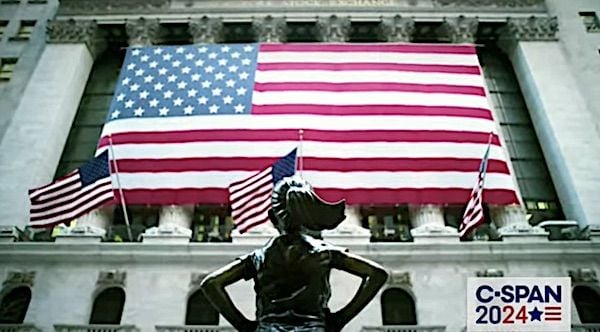Tech billionaire defends massive H-1B labor pipeline, warns Trump’s reforms will ‘backfire’
By Amanda Bartolotta
Copyright wnd

Michael Moritz, the billionaire venture capitalist and longtime Silicon Valley insider, published an opinion piece in the Financial Times attacking President Donald Trump’s $100,000 fee on H-1B visa petitions. Moritz claimed the policy would damage America’s tech industry rather than protect U.S. workers. In a dramatic flourish, he likened the White House to The Sopranos, calling the fee a “caper” and accusing the administration of failing to understand “why the U.S., especially its technology sector, has worked so well.”
This debate is about more than Moritz’s claims. It reveals how language can be used to reframe the issue, obscure accountability and pressure policymakers into surrendering leverage to global capital at America’s expense. Moritz is only the latest voice using familiar arguments that have long perpetuated harm to U.S. workers. The difference is that the facts, unlike opinions, can be tested, verified and held up against the record.
The blurred line between ‘skill shortage’ and ‘labor arbitrage’
Moritz argues that big tech “hires foreign nationals because they possess particular skills” and fill “areas where the U.S. has labor shortages.” But the so-called “skilled worker” narrative surrounding the H-1B visa is a total and provable myth. The H-1B program was originally pitched as a way for U.S. companies to bring in highly skilled workers when no qualified Americans could be found. But decades of evidence show that corporations use it not to fill rare gaps, but to import cheaper labor and displace U.S. professionals.
Even the program’s mechanics point away from merit. The H-1B system allocates visas by random lottery, not by skill, wage level or national need. Instead, it’s the luck of the draw, not merit that wins out.
The records that employers submit to the Department of Labor through the so-called PERM process tell a much different story.
PERM (Permanent Labor Certification) is the only stage wherein employers are legally required to test the U.S. labor market before sponsoring a foreign national for permanent residency. If there truly were a skilled labor shortage, corporations would embrace that safeguard. Instead, they cleverly design myriad ways to avoid finding qualified Americans. Job ads are drafted with inflated requirements that few domestic candidates will meet. Notices are intentionally placed where they are unlikely to be seen. Ads are run only in the bare-minimum formats required by regulation. And after layoffs, companies like Google and Amazon simply pause PERM filings to avoid having to offer jobs back to the Americans they just terminated, a tactic openly advised by immigration attorneys.
Moritz reinforces his point by listing “warehouse workers, account managers, brand specialists and dishwashers” as the kinds of jobs Americans hold. The effect is to suggest that only foreign workers fill demanding roles such as biochemists, software engineers and other high-skill positions, while Americans are concentrated in lower-level work. This framing makes U.S. layoffs and new H-1B requests appear unrelated, as if the Americans being cut were never in the same labor pool and therefore didn’t qualify for the legal notice requirement.
Evidence from ongoing litigation shows otherwise.
One company email cited 209 employees whose layoffs created a legal barrier to sponsoring foreign nationals in those same roles. Despite acknowledging the requirement to notify displaced Americans, the company treated them as an obstacle to be managed, rather than candidates to be rehired.
This contrast with the H-1B program is critical. Unlike PERM, H-1B petitions do not require any recruitment or labor market test. Employers can file directly for foreign workers without demonstrating that no qualified Americans are available. The way companies work around the one safeguard that does exist indicates that qualified Americans are indeed available, but employers simply choose not to hire them.
‘Every bit as well qualified as their American counterparts’?
Moritz’s claims that undergraduate degrees from Eastern Europe, Turkey or India are “every bit as well qualified” as American degrees do not stand up to global data. In the “QS World University Rankings 2026,” U.S. institutions dominate the top tier, with MIT ranked #1 for the 13th consecutive year and over 40 U.S. universities in the top 200. By contrast, India’s highest-ranked school, IIT Delhi, sits at 123rd and most Indian universities fall far lower.
The Times Higher Education 2025 rankings show a similar pattern: The U.S. holds 7 of the top 10 universities worldwide, while India’s best performer, IISc Bangalore, is ranked in the 201-250 band, with the majority falling 600+ or unranked.
Quality concerns are reflected in employability data. Studies show that of Indian engineering graduates, approximately 94% lack the skills required for employment, with only 4.77% able to complete a basic programming task. These findings contrast sharply with Moritz’s assertion and raise questions about the pipeline that supplies roughly three out of every four H-1B visas.
Opinion doesn’t conceal facts: Documented cases of replacement
Moritz insists that U.S. companies do not hire H-1B workers “to deprive Americans of jobs or for cost reasons.” But documented cases prove otherwise.
In 2015, Disney made headlines when IT employees were ordered to train H-1B replacements supplied by HCL. At Southern California Edison, hundreds of American IT roles were cut and replaced with H-1B contractors. The University of California required career staff to train incoming HCL hires.
AT&T, after a $3 billion tax cut, expanded its outsourcing partnerships, displacing more than 16,000 Americans and closing 44 call centers.
At Bank of America, the company acknowledged requiring U.S. employees to train foreign replacements, calling it “essential for knowledge transfer.” One employee, Kevin Flanagan, took his own life after being forced to train his foreign replacement, underscoring the human toll of these practices.
These are just a few of many verifiable cases, not anecdotes. They demonstrate a pattern in which American workers are displaced while visa pipelines remain open and expanding.
It’s all about cheap labor, not ‘rare skills’
Supporters often frame H-1B hiring as access to rare, high-end talent. But the government’s own data shows otherwise. Employers must classify H-1B jobs under one of four prevailing wage levels: Level 1 is “entry level,” while Level 4 reflects senior, fully competent roles.
Employer records reveal that 83% of H-1B registrations fall into Levels I and II, both below the U.S. median wage. In computer and mathematical jobs, the single largest category, 271,000 of 315,000 filings, were placed at these lowest levels. Even in business and finance, nearly 80% landed at Levels I and II. Across the top five job categories, as little as 14% were classified at Levels III and IV.
If the program were truly about filling rare shortages, employers would be filing at higher wage levels. Instead, filings cluster overwhelmingly at the bottom. The data shows that the H-1B program functions as a pipeline for lower-cost labor on a massive scale.
India’s government confirms: H-1B fuels exports, not shortages
In a Bloomberg article titled “India Seeks Access for Workers in US Trade Talks After H1B Blow”, Indian officials openly acknowledge the real function of the H-1B program. India Commerce Minister Piyush Goyal told U.S. negotiators that the “mobility of skilled workers” is vital to India’s services exports. In plain terms, the H-1B program is not being used to solve America’s skill shortages; it is a pipeline that converts U.S. jobs into India’s export product. And the vehicle making this possible is not trade law, but America’s own immigration system.
The report also shows that India views Trump’s $100,000 H-1B fee not as an obstacle to filling U.S. skill shortages, but as a direct threat to its $280-billion tech services industry. For American workers, the consequences are twofold. First, jobs are lost at home when companies bring in lower-cost visa holders. Second, those same roles are exported overseas under the banner of “services,” turning U.S. employment into an international commodity.
The hard truth: The H-1B program fails to protect Americans
Moritz argues that U.S. law protects citizens from being replaced by H-1Bs. In reality, the program is structured in ways that leave Americans exposed. Employers are generally not required to recruit U.S. workers before hiring H-1Bs. Only a narrow subset of “H-1B-dependent” employers face additional rules, and those rules contain significant loopholes.
Mst companies simply attest that they will not displace U.S. workers in the exact same job classification. Nothing prevents them from laying off staff in one unit while filling nearly identical roles with H-1Bs through outsourcing vendors.
The Department of Labor’s Inspector General has reported widespread fraud and abuse in the program and found oversight grossly insufficient. The result is a system where violations are frequent, consequences rare and displacement, both direct and indirect, widespread.
Veiled threats: The implied ultimatum
Moritz warns that “advances in technology mean that it is less important for the tech companies to bring workers to America,” implying that if the U.S. restricts visas, companies will simply take the work abroad.
Such statements raise questions about corporate loyalty to their country, America. With U.S. consumers generating the majority of revenue, the suggestion that jobs can simply be shifted elsewhere overlooks the role of American workers and taxpayers in building these companies.
If firms choose to move operations overseas, policymakers could require repayment of subsidies, grants and tax breaks and retention of patents developed with U.S. funding. Policy makers should also implement new policies on offshoring and safeguarding American data from being transferred abroad, where privacy protections are weak or unenforceable.
Narrative capture disguised as innovation
Michael Moritz argues that the Trump administration should not shrink the H-1B program but instead double or triple visa numbers and automatically grant U.S. citizenship to foreign nationals earning PhDs in STEM fields from top American universities. He frames this as essential to keeping top talent from leaving for other countries.
However, proposals of this kind would expand the supply of foreign labor, lock in employer access to it and make it more difficult for policymakers to reduce numbers later. Each step strengthens corporate reliance on foreign workers rather than on the domestic labor force.
When Moritz and others call for increasing visa numbers under the banner of “economic fundamentals,” the result is an expanded supply of lower-cost labor for corporations. In this framework, “innovation” becomes linked less to investing in American workers and more to enlarging the pool of foreign labor that can be brought in.
Moritz also points to his own immigration story as evidence that visa pipelines should be widened. Even after nearly 50 years in the United States and despite clear benefits from the American economy, his framing suggests that assimilation and citizenship are optional.
In this view, American loyalty and sovereignty take a back seat to profit. Being American in America appears conditional, valued only so long as it aligns with higher financial returns. If greater profits can be found elsewhere, America itself is presented as interchangeable, or even for sale.
Moritz’s op-ed frames resistance as xenophobic, backward or disconnected from “global realities,” while presenting the movement of jobs abroad as the natural fallback. Yet America’s strength has historically come from deliberate design, sovereignty and investment in its own workforce. The fortunes of the investor class were built on this foundation, even as current arguments push in the exact opposite direction. Moritz portrays his stance as safeguarding talent, but the emphasis aligns consistently with safeguarding financial returns.
Restoring America’s promise
The debate over H-1B visas is not about talent, progress or global competitiveness. It is about whether the United States will continue to sell out its workers, its sovereignty and its future for the short-term profits of the investor class.
Michael Moritz’s arguments highlight a worldview where citizenship, assimilation and American loyalty are treated as optional and where the nation’s worth is reduced to margins on a balance sheet.
The United States and its citizens were never meant to be interchangeable with others. The country was built on purpose, pride and sacrifice. Its strength has always come from investing in its own people, defending its sovereignty and ensuring that opportunity belongs first to the citizens who built and sustained it.
If America is to secure the next century, policymakers must stop treating the displacement of American workers as collateral damage and start addressing it as the true national emergency it is.
Immigration policy must serve the interests of American citizens, not the balance sheets of multinational corporations or the export ambitions of foreign governments.
The choice is to stand with American workers or surrender the nation’s future. To keep the United States free, strong and sovereign, its leaders must protect American jobs, innovation and people – because America is not for sale.



